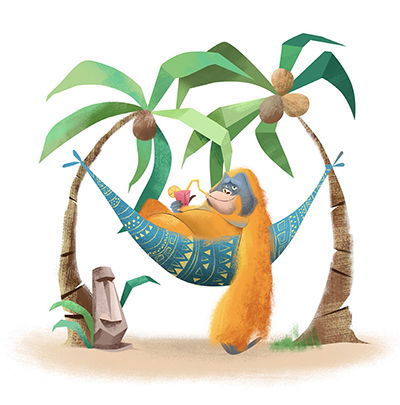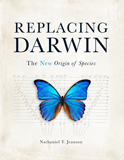Orangutan—King of the Treetop Trapeze
With their red hair and funny faces, orangutans have won a place in our hearts. But they stand out, even among apes, for other reasons too.
A man-sized mass of orange hair, the creature looks too big to actually live in the trees. Yet there he is, crouching casually on a branch 50 feet in the air, lazily munching his leafy lunch. Then, placing his food on his head, he gracefully swings down a branch.
They’re called orangutans for a reason, and it isn’t because they’re orange (or tan). Orangutan means “person of the forest.” Anyone who has watched these magnificent animals knows how uncannily human they sometimes seem. But are they really our cousins, or are they a uniquely designed, unrelated kind of creature?
Not Your Average Ape
As large, tailless primates, orangutans belong (along with chimpanzees, bonobos, and gorillas) to the great ape kind, created on day six of creation week. But orangutans stand out. They are the only Asian great apes, living in the rainforests and swamp forests on the islands of Borneo and Sumatra. And while the African apes are good climbers, orangutans make them look like downright amateurs.
The largest tree-dwelling mammals in the world, orangutans are well-designed for tree life. They spend most of their daylight hours in the canopy foraging for their favorite foods, and at night, they sleep among the branches.
Anatomy of a Tree-Dweller
Those lanky arms and short legs may look comical, but their proportions are ideal for climbing. Unlike you, with your long legs and short arms (don’t take that as an insult), orangutans have really long arms. An orangutan your size will have arms twice as long as yours. That’s long even for an ape—chimps’ arms are only about the same length as their legs, while orangutan arms are almost one-and-a-half times as long. (Ours are a measly two-thirds as long.)
Those arms come with many tree-faring features. The bones and muscles of their shoulders, elbows, and wrists allow for great mobility and force. Their long, curved phalanges (finger and toe bones)—more curved than any other living primate—serve as hooks to hang from, reduce bone strain, and minimize the force necessary for gripping branches.

And don’t knock those short legs; they’re especially tree-worthy. Unlike us, orangutans basically have two sets of arms. Their hips, as mobile as shoulders, can adopt extreme positions, like doing “the splits” while grasping branches with both feet (don’t try it). They also have a different arrangement of muscles in their hips that African apes do not have, allowing for more types of movement. And of course, their feet function like hands.
It isn’t all in the limbs. Their enormous jaws can rip bark off trees and crack nuts (don’t try that either). Also, because climbing often demands the full attention of both hands (and feet), they carry things with their mouth.
But their climbing anatomy gets them only so far. Orangutans are also famous for their astounding intelligence.
Brainy as Well as Brawny
Life in the forest is rough, so a little savvy goes a long way. Orangutans are even better tool users than chimps, making the most of the sticks and branches all around them. Skilled engineers, they braid branches into sturdy, comfy nests and use them in preparing food and reaching far-off necessities. They’ll chew up leaves of medicinal plants and rub them on their bodies to alleviate soreness. And if the jungle itself doesn’t give them what they need, they can also appropriate (read: steal) manufactured objects, such as canoes, or hitch a ride on cable cars, to the chagrin of many a human owner.
Orangutans are gifted communicators. Their oral repertoire, important for warning off predators and finding mates, includes roars, kissing noises, and spittle-suffused raspberries. They use gestures and imitation to pass on new skills—sometimes miming actions they want others to perform. They’ve even picked up charming behaviors from humans, such as whistling, sign language, and simple vocal sounds.
Orangutans’ marvelous minds have limits though. They can “ape” routines such as brushing teeth and even washing laundry but without understanding their purpose. While these animals’ fascinating ability to interact with us is a gift, they still do not enjoy the unique status God gave human beings.
Close Cousins or Separate Creations?
Rather than “people of the forest” or humanity’s cousins, orangutans are special, tree-dwelling apes that God created to display his glory. They point us toward the great Engineer who made them to be such able and intelligent climbers. Their delightful similarity to us reminds us of our own uniqueness. As close as we may seem in some respects, the gap is unbridgeable.
As the only beings created in God’s image, we have a unique duty and ability to shepherd God’s creation, including these tree-loving marvels that now face extinction.
Did You Know . . .

Illustration by Dave Mottram
Home improvers to the core, orangutans sometimes add deluxe amenities to their nests, including water-resistant roofs, a second “bunk” bed above them, blankets, and pillows (with the twig-ends facing outward).
Their orange hair matches the dead leaves in the canopy and the muddy water below, making it surprisingly good camouflage.
Orangutans can learn sign language. One learned to use at least 150 words and even made up new words by combining old ones.
Their nests can be as high as 100 feet up in the trees. Yikes!
If orangutans come off as lazy, it isn’t just your imagination. They’re mellow for a reason. Their laid-back lifestyle helps them preserve energy in the hot, humid rain forest.

Illustration by Dave Mottram
Answers Magazine
September–October 2018
Even as skepticism spreads around the globe, the creation movement is flourishing. Meet some of the new generation of creation scientists.
Browse Issue SubscribeRecommended Resources

Answers in Genesis is an apologetics ministry, dedicated to helping Christians defend their faith and proclaim the good news of Jesus Christ.
- Customer Service 800.778.3390
- © 2024 Answers in Genesis







